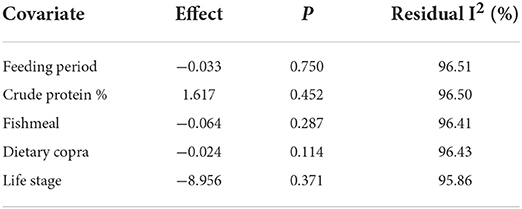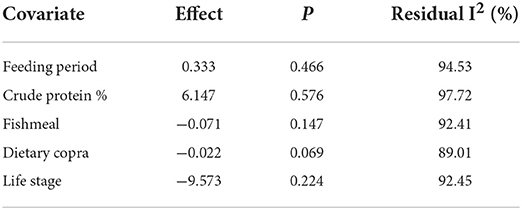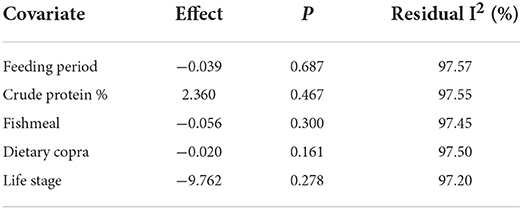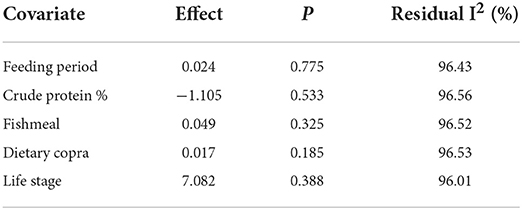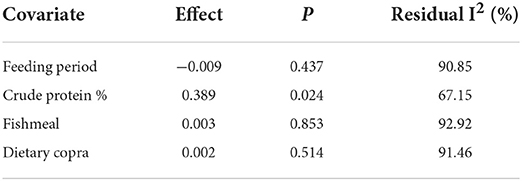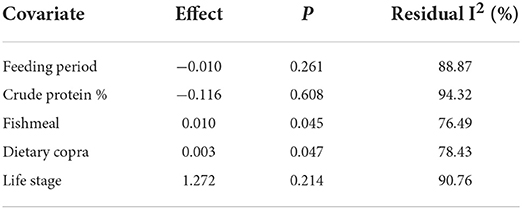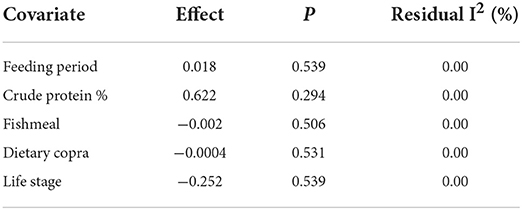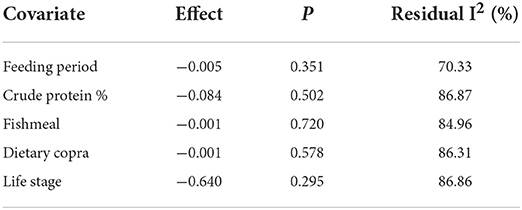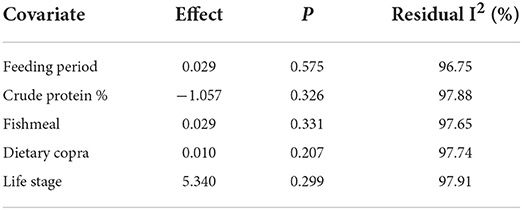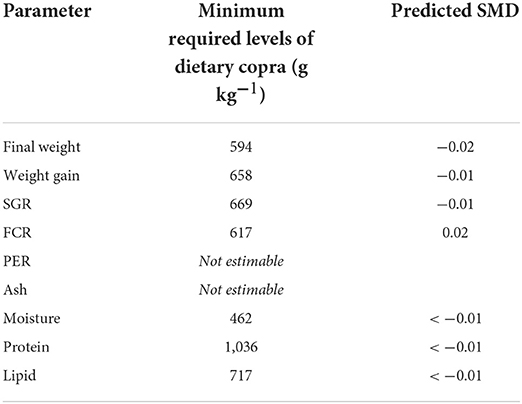- Ateneo Aquatic and Fisheries Resources Laboratory, Department of Biology, School of Science and Engineering, Ateneo de Manila University, Quezon City, Metro Manila, Philippines
Introduction: Nile tilapia (Oreochromis niloticus) is one of the most cultured species in the aquaculture industry. However, its market price is affected by the increasing cost of fishmeal. Plant-based proteins are being used to mitigate the problem.
Methodology: This paper comprehensively quantified the growth performance and carcass composition of Nile tilapia fed copra meal via systematic review and meta-analysis. The literature review and paper selection were done based on the preferred reporting items for systematic reviews and meta-analysis method. The data from peer-reviewed papers that qualified from the inclusion screening criteria such as standard error reporting, feeding period, absence of dietary supplements, tilapia development stage, and crude protein levels were subjected to meta-analysis.
Results: Results showed that growth and feed utilization parameters were significantly different (P ≤ 0.05), favoring the control over the plant-based diets. Moreover, the pooled estimate of carcass composition of fish fed copra meal-based diet was not significantly different with that of fish fed fishmeal-based diet (P > 0.05) except for ash content (P < 0.05). The feeding period, crude protein level, fish development stage, and dietary copra inclusions were subjected to meta-regression analysis due to high and statistically significant I2 values to determine the sources of heterogeneity. The residual I2 values showed that these factors did not affect the heterogeneity of the data presented for copra meal. These effects may be attributed to the nutritional quality of raw materials and other abiotic factors like feed preparation.
Conclusion: Nonetheless, data from meta-analysis using model coefficients revealed that the minimum required levels are 594, 617, and 462 g kg−1 of dietary copra meal are needed for optimum growth performance, feed utilization, and carcass composition of Nile tilapia, respectively. The study showed that systematic review and meta-analysis can be a useful tool in optimizing plant-based diets for aquaculture species.
Introduction
In global aquaculture, tilapia industry is one of the most stable and fast-growing. Nile tilapia (Oreochromis niloticus) is the top-ranked and most important tilapia species being cultured and traded. Its pivotal role in meeting the global demand for fish product was seen in 2017 where almost 40% of the supply came from tilapia culture (Prabu et al., 2019). Thus, tilapia production benefits livelihood, research, income generation, and market trade.
Feeding accounts to almost 50% of fish culture costs. Fishmeal, which is the main protein source in fish feeds, has been steadily dwindling in supply and increasing in cost. Local plant-based proteins such as soybean, corn, palm kernel and pea meal (Magbanua and Ragaza, 2022) are excellent alternatives to fishmeal. Plant-based proteins are readily available in the market and contain high amount and good quality of proteins. However, these plant-based proteins contain insufficient amount of essential amino acids (Hardy, 2010) and lack active compounds that are otherwise markedly present in commercial fishmeal (Gatlin et al., 2007).
Copra meal is a readily available raw material that is globally used as an animal feed additive especially in poultry. In aquaculture, copra meal was seen to be a feasible partial protein source for fish feed as it can provide sufficient apparent digestibility (Santos et al., 2009) and better growth rate (Olude et al., 2008) in Nile tilapia fingerlings.
Un-processed copra meal can directly replace 300 g/kg fishmeal for Nile tilapia without any negative effects on feed intake (Obirikorang et al., 2015). Moreover, high inclusion of copra meal (680 g/kg) supplemented with sesame meal to make up for the lack in methionine can replace fishmeal in Nile tilapia diets without eliciting detrimental effects (Obirikorang et al., 2016). In a separate study, copra meal can be incorporated in tilapia diets up to 30% (Olude et al., 2008). Its crude protein, apparent dry matter digestibility, digestible energy, and gross energy were found sufficient in Nile tilapia diets (Santos et al., 2009). Although copra meal is inexpensive and proteinaceous, copra meal lacks methionine and contains ANF such as phytic acid, protein inhibitors, and saponins (Francis et al., 2001).
In a study, guar meal and copra meal fermented via Saccharomyces cerevisiae was used to substitute fishmeal in Nile tilapia diets. There was an increase in the fish weight gain, lipid composition and protein contents at 25% replacement (Dileep et al., 2021). The hematological analysis revealed that the fish digestive enzymes, liver enzymes, and blood serum parameters such as alanine aminotransferase and aspartate aminotransferase were all unaffected by the copra meal inclusion.
This paper uses systematic review and meta-analysis to quantify the growth performance and carcass composition of Nile tilapia fed copra meal. The present study also aims to determine the effects of exogenous and endogenous feeding factors on the response of Nile tilapia fed plant-based proteins. The use of meta-analysis reveals the heterogeneity across related studies and provides a pooled result.
Methodology
Search strategy and inclusion criteria
A search strategy published by preferred reporting items for systematic reviews and meta-analysis (PRISMA) was used in the current study. Literature search was done using the following search engines, such as, Google scholar, EBSCO Discovery Search—Ateneo de Manila University, Taylor and Francis, Wiley Online Library, and Scopus. Studies published from 1960 to 2022 were covered. Studies focusing on fishmeal replacement using copra meal was included in the study. The literature search used the combinations of the following keywords: copra meal, fishmeal, fishmeal replacement, fish feed. Only peer-reviewed papers were included in the study to maintain quality and credibility (Ahn and Kang, 2018). Literatures in English language were selected. Furthermore, the inclusion criteria were established to gather appropriate studies for the systematic review and analysis. The criteria include the following: (a) sufficient growth parameters (i.e., final weight, SGR, PER, %WG) and carcass composition data with standard errors; (b) feeding trial is at least 6 weeks; (c) copra meal gradually replaced fishmeal in the Nile tilapia diet; (d) a control must be present (i.e., a fishmeal-based diet); (e) no supplementations of crystalline amino acids, any enzymes or supplements; (f) no plant protein mixtures; (g) clear mention of Nile tilapia growth stage (i.e., fingerling, juvenile, adult); and (h) test diets should be iso-nitrogenous ranging from 30 to 45% crude protein.
The selection criteria include factors that can directly affect fish growth performance and carcass composition. For instance, standard errors in each variable were required for meta-analysis. Feeding duration was set at least 6 weeks, which is the minimum standard for feed use and effectiveness in fish culture. This means that significant growth from juveniles can be observed at the end of 6-week feeding period. Fishmeal-based control was included to serve as a reference for the changes brought by the test feeds. Studies that used crystalline amino acids, probiotics, exogenous enzymes, and any supplements in the diets were disregarded because these substances can directly affect the overall fish performance. Lastly, diets that followed the standards of the dietary crude protein % in each life stage set by Food and Agriculture Organization were selected.
Effect size calculation
The overall growth and carcass composition means and standard deviation data were treated using Hedge's g (Novriadi, 2017) to measure the estimated effect of copra meal inclusions in the Nile tilapia diets. Growth variables evaluated in the study are final weight, specific growth rate (SGR), protein efficiency ratio (PER), feed conversion ratio (FCR), and percent weight gain (%WG). For carcass composition, the study used protein, lipid, moisture, and ash contents as variables. A positive or negative value from this treatment served as basis for the effects of copra meal on the different independent variables. In each analysis, I2 was used to measure and quantify heterogeneity among studies.
Meta-regression analysis
A random-effect model via meta-regression analysis was used to explain the heterogeneity in the study with copra meal as predictor. Covariates that were selected for meta-regression are fish life stage, fishmeal inclusion level, dietary copra meal inclusion level, crude protein percentage, and feeding period. These covariates were selected because these are exogenous and endogenous factors wherein values are different between included literatures. Effect size calculation and meta-regression analysis were all analyzed and processed using Stata software.
Results
Literature search and inclusion
Figure 1 shows the number of literatures gathered from different databases, screened using inclusion criteria, and total papers included in the review. A total of 839 search results coming from five search engines were collected and subjected to the initial screening. Fifteen papers were excluded as those are duplicates of other search results. Then, 824 were screen based on the nature of the study and their title. A total of 741 studies were excluded because the focus of each study did not pertain to fishmeal replacement using copra meal and the fish species used was not Nile tilapia. The remaining 83 studies were accessed online and assessed based on its abstract and data availability. The abstract screening removed 64 studies as the focus of the literature did not qualify for the inclusion criteria. Moreover, 14 studies were excluded due to either the missing standard errors for growth and carcass composition parameters or the different parameters evaluated.
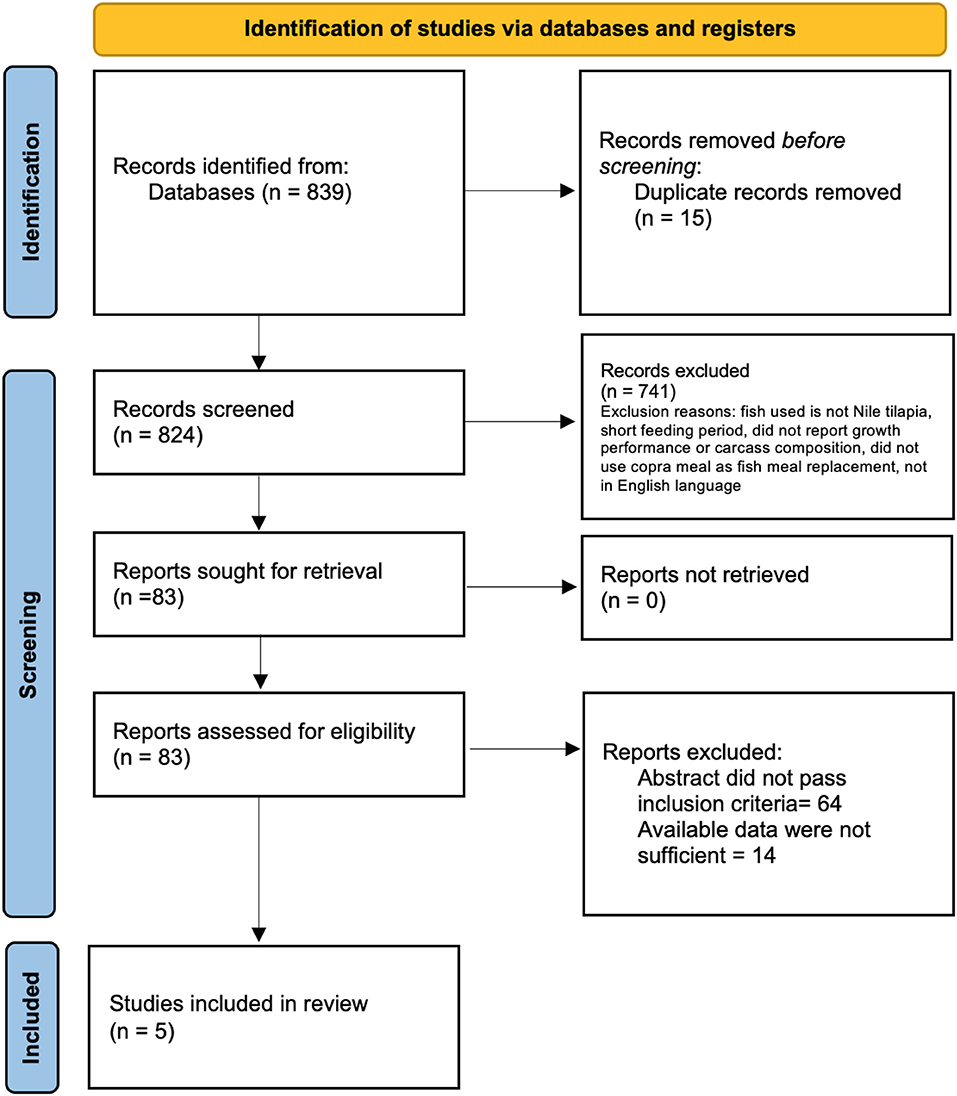
Figure 1. Literature search and inclusion of related studies on copra meal as fishmeal replacement for Nile tilapia diet.
Effect size calculations
Based on the results (Table 1), all the growth response and feed utilization variables were significantly different (P ≤ 0.05) between the control and copra treatment. All of them were in favor of the control as indicated by the positive SMD values. For instance, the mean weight gain under the control arm is higher by 55.464 g compared to the copra treatment. For FCR, a lower value is desirable. Thus, negative SMD means that the control is favorable over the treatment. For carcass composition, only the ash content was significant. The mean ash in the control arm was higher by 0.049%. On the other hand, the mean values for moisture, protein, and lipid between the control and copra treatment were not significantly different (P > 0.05).
Heterogeneity tests showed that SMDs of all the variables except moisture were heterogeneous. The differences among study results were not fully accounted for by the analysis; there are other factors that need to be investigated to account for this heterogeneity. In the case of moisture, the SMDs are not heterogeneous (P = 0.533) with an I2 = 0.00%. This means that the four sets of study results used in the analysis fully accounted for the variation in moisture content. This can also mean that the selected studies are homogenous for moisture content as a variable and no co-variates are needed to be analyzed via meta-regression.
Meta-regression
For final weight (Table 2), the fish life stage had the highest effect. A negative value in fish life stage indicates that an adult Nile tilapia had higher SMD (i.e., difference = fingerling – adult). The control treatment has significantly higher adult tilapia final weight compared to fingerlings. For quantitative factors, all except CP% had negative effects. Negative effect values for feeding period, fishmeal, and dietary copra are negatively associated to SMD. This means that a longer feeding period or a higher fishmeal or dietary copra inclusion leads to a smaller SMD (i.e., approaches negative value). As the value leads to a negative value in each parameter, in this case, a longer feeding period or a higher fishmeal or dietary copra inclusion, there is higher final weight in tilapia fed the copra treatment. On the other hand, CP% is positively associated to SMD. This means that the final weight in tilapia fed a control diet increases when the CP% of the diet is higher. However, none of these effects are statistically significant (P > 0.05) and a large percentage of heterogeneity is still unexplained as shown by the high residual I2.
For weight gain (Table 3), the fish life stage had the highest effect. A negative value means that the adult type had higher SMD. This means that control treatment has significantly higher weight gain in Nile tilapia adults than in fingerlings. For the quantitative factors, fishmeal and dietary copra had negative effects. Hence, fishmeal and dietary copra are negatively associated to SMD. This means that higher fishmeal or dietary copra inclusion leads to a smaller SMD (approaches negative value). The copra treatment arm is expected to have higher weight gain if the fishmeal or dietary copra inclusion is higher. On the other hand, the feeding period and CP% are positively associated to SMD. This means that a longer feeding period or a higher CP% leads to a higher SMD (approaches positive value). This means that higher weight gain is expected in the control treatment when either the feeding trial is longer or the CP% of the diet is higher. However, none of these effects are statistically significant (P > 0.05) and a large percentage of heterogeneity is still unexplained as shown by high residual I2.
For SGR (Table 4), life stage had the highest effect. A negative value means that the adult type had higher SMD. Tilapia fed control has higher SGR in Nile tilapia adults. For the quantitative factors, all except CP% had negative effects. Being negative, feeding period and fishmeal and dietary copra inclusions are negatively associated to SMD. This means that a longer feeding period or a higher fishmeal or dietary copra inclusion leads to a smaller SMD (approaches negative value). This means that the fish fed copra treatment is expected to have higher SGR if there is a longer feeding period, or a higher inclusion of fishmeal or dietary copra. On the other hand, CP% is positively associated to SMD. This means that a higher CP% leads to a higher SMD (approaches positive value). Tilapia fed control diet will have a higher SGR when the CP% of the diet is higher. However, none of these effects are statistically significant (P > 0.05) and a large percentage of heterogeneity is still unexplained as shown by high residual I2.
For FCR (Table 5), life stage had the highest effect. A positive value means that a fingerling Nile tilapia had higher SMD. The copra treatment has higher FCR in Nile tilapia fingerlings. The forest plot for FCR shows that SMD is positive in the study of Obirikorang et al. (2016), which used Nile tilapia fingerlings. For the quantitative factors, all except CP% had positive effects. Hence, feeding period and fishmeal and dietary copra inclusions are positively associated to SMD. This means that a longer feeding period or a higher fishmeal or dietary copra inclusion leads to a higher SMD (approaches positive value). This will entail better FCR in tilapia fed copra treatment if the feeding period is longer or if the fishmeal or dietary copra inclusions is higher. On the other hand, the CP% is negatively associated to SMD. A higher CP% leads to a smaller SMD (approaches negative value). This means that tilapia fed control diet is expected to exhibit better FCR when the CP% of the diet is higher. However, none of these effects are statistically significant (P > 0.05) and a large percentage of heterogeneity is still unexplained as shown by high residual I2.
For PER (Table 6), the CP% of the diet had the highest effect. A positive value means that a higher CP% leads to higher SMD. This effect was found to be significant (P ≤ 0.05) and the residual I2 went down to 67.15% only. For the other quantitative factors, all except feeding period had positive effects. Hence, fishmeal and dietary copra inclusions are positively associated to SMD. This means that higher a fishmeal or dietary copra inclusion leads to a higher SMD (approaches positive value). Tilapia fed control is expected to have higher PER if the inclusion of fishmeal or dietary copra is higher. On the other hand, the feeding period is negatively associated to SMD. A longer feeding period leads to a smaller SMD (approaches negative value). This means a higher PER is expected in tilapia fed copra treatment when the feeding period is longer.
For ash content (Table 7), life stage had the highest effect. A positive value means that the adult Nile tilapia had higher SMD. When tilapia is fed a control diet, the control diet increases the carcass ash composition among adults. For the quantitative factors, the feeding period and CP% had negative effects. Hence, the feeding period and CP% are negatively associated to SMD. This means that a longer feeding period or a higher CP% leads to a smaller SMD (approaches negative value). Tilapia fed copra treatment is expected to have higher carcass ash composition when the feeding period is longer or if the CP% of the diet is higher. On the other hand, fishmeal and dietary copra inclusions are positively associated to SMD. This means that a higher fishmeal or dietary copra inclusion leads to a higher SMD (approaches positive value). Tilapia fed control diet has higher carcass ash composition when the fishmeal or dietary copra inclusion is higher; these effects are statistically significant (P ≤ 0.05).
For moisture content (Table 8), the CP% of the diet had the highest effect. A positive value means that a higher CP% in the diet leads to a higher SMD. Tilapia fed control has higher carcass moisture composition if CP% of the diet is higher. For the other quantitative factors, feeding also had positive effects. On the other hand, fishmeal and dietary copra inclusions are negatively associated to SMD. Tilapia fed copra treatment has higher carcass moisture composition when the fishmeal or dietary copra inclusion is higher. However, none of these effects are statistically significant (P > 0.05). All residual I2 are zero since heterogeneity is 0% in the meta-analysis for moisture content.
For protein composition (Table 9), the life stage had the highest effect. A negative value means that the Nile tilapia adult had higher SMD. Tilapia adults fed control has higher protein composition. For the quantitative factors, all had negative effects. This means that a longer feeding period or a higher CP% or a higher fishmeal or dietary copra inclusion leads to a smaller SMD (approaches negative value). Tilapia fed copra treatment has higher carcass protein composition if the feeding period is longer, or if the dietary CP% is higher, or when the inclusion of fishmeal or dietary copra is higher. However, none of these effects are statistically significant (P > 0.05) and a large percentage of heterogeneity is still unexplained as shown by high residual I2.
For lipid composition (Table 10), the life stage had the highest effect. A positive value means that Nile tilapia fingerlings had higher SMD. Tilapia fingerlings fed control diet has higher carcass lipid composition. For the quantitative factors, all had positive effects except CP%. This means that a longer feeding period or a higher fishmeal or dietary copra inclusions leads to a higher SMD (approaches positive value). Tilapia fed control diet has higher carcass lipid composition if the feeding period is longer or if the inclusion of fishmeal or dietary copra is higher. On the other hand, carcass lipid composition is expected to increase in the copra treatment when CP% is higher. However, none of these effects are statistically significant (P > 0.05) and a large percentage of heterogeneity is still unexplained as shown by high residual I2.
Listed in Table 11 are the minimum required levels of dietary copra for each parameter which will result in a negative predicted SMD. If the predicted SMD is negative, it means that the copra treatment is favorable over the control (except for FCR where a positive SMD is preferred). The minimum copra meal inclusion is at a level of 462 g kg−1 fishmeal replacement for a favorable final weight. The highest inclusion is at a level of 1,036 g kg−1 for a favorable total body protein composition.
Discussion
Feeding costs account to 50% of the total aquaculture expenditure, with protein sources as the most expensive component (Mzengereza et al., 2014). The aquaculture industry is dependent on fishmeal as the main protein source for feeds. Fishmeal contains balanced number of amino acids that supports proper growth and health of fish. However, its cost continues to rise, consequently affecting the market price of fish.
In the present study, copra meal was comprehensively evaluated as a fishmeal replacement for Nile tilapia (Oreochromis niloticus) diets via a systematic review and meta-analysis. Available studies (Bamba et al., 2014; Obirikorang et al., 2015, 2016; Duodu et al., 2019; Yossa et al., 2021) on the this plant-based ingredient show varied results. Thus, using peer-reviewed literatures, the current study aimed to quantitatively generalize the effects of dietary copra meal inclusions on the growth response and carcass composition of Nile tilapia O. niloticus.
The growth performance of fish is directly related to its nutrition. The pooled estimate in the meta-analysis of the growth performance of Nile tilapia fed dietary copra meal is significantly higher in the control compared to the copra treatment. Though the relationship is not statistically significant, meta-regression showed that the crude protein level of the diet has a positive effect on the SMD in all growth parameters. This means that the lower the crude protein of the feed, there is an expected increase in the growth parameter values of Nile tilapia fed copra meal treatment. High protein levels are associated with excess amino acids that undergo excretion and deamination, rendering them unused for fish growth (Luthada-Raswiswi et al., 2021).
The present results agree with previous studies that showed deleterious effects on fish performance when there is high inclusion of copra meal (Hasan et al., 1997; Olude et al., 2008). The screened papers used in the present study supplemented copra meal at very low to extremely high levels. Only two literatures used < 30 g kg−1 of copra meal while the rest used more than 300 g kg−1. Copra meal lacks essential amino acids such as lysine and methionine (Ohler, 1999) and has low protein content and high crude fiber (Hertrampf and Piedad-Pascual, 2000). These attributes could have contributed to the inefficiency of copra meal as a fishmeal replacement. Protein quality in fish feeds plays a key role in fish performance (Abdel-Warith et al., 2001; Keramat Amirkolaie et al., 2014).
The proximate analysis of the tilapia carcass may be influenced by the nutritional composition and quality of feed ingredients. All the carcass proximate composition values except ash of tilapia fed plant-based protein sources were not statistically different from tilapia fed a fishmeal-based diet. Acceptable and standard carcass composition values in grouper (Epinephelus fuscoguttatus) (Mamauag and Ragaza, 2019) and common carp (Cyprinus carpio) (Yusup, 2017) have been recorded when fed dietary copra meal. This may be explained by the sufficiency of copra meal's crude protein, apparent dry matter digestibility, digestible energy, and gross energy (Santos et al., 2009). Ash composition may also be attributed to the nutrient and mineral content of other feed materials excluding the protein source.
The parameters or factors in the present study were subjected to meta-regression due to the high heterogeneity. Meta-regression aims to identify the source/s of heterogeneity from the meta-analysis. Co-variates including feeding duration, fish life stage, crude protein %, fishmeal level, and dietary copra meal level were identified. The mentioned co-variates were chosen as these showed different values across literatures included in the review. The residual I2 and effect P values revealed that all the co-variates did not cause the heterogeneity in the meta-analysis except for the moisture content of the feed. The feed preparation and proximate characteristics or composition of the dietary copra meal used may have also caused heterogeneity. Feed preparation and proximate composition of the copra meal were not accounted in the present study as these were not reported in the selected studies.
The method/s used for feed and/or ingredient preparation can affect fish performance. For instance, fermentation of copra meal can increase its efficiency as a fishmeal replacement (Dileep et al., 2021) since the additional fermentation step degrades some of the non-nutritional contents in copra meal, including high dietary fiber (Harlina et al., 2021).
The nutritional characteristics or proximate composition of the dietary copra meal can also affect fish performance. Copra meal is reported as inferior to other plant-based proteins such as soybean due to its lower and varying nutritive contents (Ohler, 1999; Heuzé et al., 2015).
The model coefficients from the meta-regression were used to identify the minimum required levels of copra meal for Nile tilapia diets. Minimum required levels indicate that at these dietary inclusion levels, proper fish growth is supported, and fish carcass composition remains normal and acceptable. Results showed that 462 g kg−1 or ~50 % of dietary copra meal can support proper growth performance and carcass composition of Nile tilapia. The same dietary inclusion level was also reported in rohu Labeo rohita (Mukhopadhyay, 2000) and Mozambique tilapia Oreochromis mossambicus (Jackson et al., 1982) fed copra meal at 50% inclusion level.
Conclusions and recommendations
Copra meal is a protein-rich and readily available fishmeal replacement. In this systematic review and meta-analysis, copra meal was reported to be an efficient partial fishmeal replacement in diets of Nile tilapia. Effect size calculations revealed that growth response parameters in Nile tilapia fed plant-based protein diets is statistically different between the control and treatment group, with the control as the favored treatment. However, carcass composition was likely not affected by both treatments.
The present study suggests that the minimum required levels are 594, 617, and 462 g kg−1 of dietary copra meal are needed for optimum growth performance, feed utilization, and carcass composition of Nile tilapia, respectively.
The study identified the probable inclusion levels of copra meal in the diets of Nile tilapia O. niloticus via meta-analysis and meta-regression. Performing actual feeding trials using the suggested minimum required levels in the diets for Nile tilapia can verify the effects on the fish performance. Furthermore, analysis of other co-variates is recommended to identify sources of heterogeneity. Feed preparation techniques and abiotic factors in the feeding trials can be additionally assessed through meta-regression as these factors can directly affect the overall fish performance.
Data availability statement
The original contributions presented in the study are included in the article/supplementary material, further inquiries can be directed to the corresponding author.
Author contributions
TM: writing the manuscript and analysis. JR: writing and editing the manuscript and proofreading. Both authors contributed to the article and approved the submitted version.
Funding
The authors acknowledge the Rizal Library Open Access Journal Publication Grant of the Ateneo de Manila University for the financial publication fee support and assistance.
Conflict of interest
The authors declare that the research was conducted in the absence of any commercial or financial relationships that could be construed as a potential conflict of interest.
Publisher's note
All claims expressed in this article are solely those of the authors and do not necessarily represent those of their affiliated organizations, or those of the publisher, the editors and the reviewers. Any product that may be evaluated in this article, or claim that may be made by its manufacturer, is not guaranteed or endorsed by the publisher.
References
Abdel-Warith, A., Russell, P., and Davies, S. (2001). Inclusion of a commercial poultry by-product meal as a protein replacement of fish meal in practical diets for African catfish Clarias gariepinus (Burchell 1822). Aquacult Res. 32, 296–305. doi: 10.1046/j.1355-557x.2001.00053.x
Ahn, E., and Kang, H. (2018). Introduction to systematic review and meta-analysis. Korean J. Anesthesiol. 71, 103–112. doi: 10.4097/kjae.2018.71.2.103
Bamba, Y., Ouattara, N., Ouattara, S., Ouattara, A., and Gourene, G. (2014). Effect of diets containing cocoa bean shell and coconut oil cake on the growth of Oreochromis niloticus (LINNE, 1758) in pond. Int. J. Biol. Chem. Sci. 8, 1368–1380. doi: 10.4314/ijbcs.v8i4.2
Dileep, N., Pradhan, C., Peter, N., Kaippilly, D., and Sashidharan, A. (2021). Nutritive value of guar and copra meal after fermentation with yeast Saccharomyces cerevisiae in the diet of Nile tilapia, Oreochromis niloticus. Trop. Anim. Health Prod. 53, 1–13. doi: 10.1007/s11250-021-02855-4
Duodu, C. P., Adjei-Boateng, D., Amponsah, A. K., Andrews, P., and Obirikorang, K. A. (2019). The effect of plant protein-based diets on apparent nutrient digestibility, growth response, e gesta quantity, postprandial ammonia excretion rate and serum quality of Nile tilapia. Aquacult. Res. 51, 1152–1161. doi: 10.1111/are.14464
Francis, G., Makkar, H.P., and Becker, K. (2001). Antinutritional factors present in plant derived alternate fish feed ingredient and their effects in fish. Aquaculture 199, 197–227. doi: 10.1016/S0044-8486(01)00526-9
Gatlin, I. I. I. D., Barrows, F., Brown, P., Dabrowski, K., Gaylord, G., Hardy, R., et al. (2007). Expanding the utilization of sustainable plant products in aquafeeds: a review. Aquacult. Res. 38, 551–579. doi: 10.1111/j.1365-2109.2007.01704.x
Hardy, R. W. (2010). Utilization of plant proteins in fish diets: effects of global demand and supplies of fishmeal. Aquac. Res. 41, 770–776. doi: 10.1111/j.1365-2109.2009.02349.x
Harlina, H., Hamdillah, A., Kamaruddin, K., and Aslamyah, S. (2021). Digestibility of fermented copra meal for fish as a plant protein source in the saline tilapia (Oreochromis niloticus) seeds. IOP Conf. Ser. Earth Environ. Sci. 763, 012033. doi: 10.1088/1755-1315/763/1/012033
Hasan, M. R., Macintosh, D. J., and Jaunceyn, K. (1997). Evaluation of some plant ingredients as dietary protein sources for common carp (Cyprinus carpio L.) fry. Aquaculture 151, 55–70. doi: 10.1016/S0044-8486(96)01499-8
Hertrampf, J. W., and Piedad-Pascual, F. (2000). Handbook on Ingredients for Aquaculture Feeds. New York, NY: Kluwer Academic Publishers, 624.
Heuzé, V., Tran, G., Sauvant, D., and Bastianelli, D. (2015). Copra meal and Coconut By-Products. Feedipedia, A Programme by INRA, CIRAD, AFZ and FAO. Available online at: https://www.feedipedia.org/node/46 (accessed May 11, 2015).
Jackson, A. J., Capper, B. S., and Matty, A. J. (1982). Evaluation of some plant proteins in complete diets for the tilapia, Sarotherodon mossambicus. Aquaculture 27, 97–109. doi: 10.1016/0044-8486(82)90129-6
Keramat Amirkolaie, A., Shahsavari, M., and Hedayatyfard, M. (2014). Full replacement of fishmeal by poultry by-product meal in rainbow trout, Oncorhynchus mykiss (Walbaum, 1972) diet. Iranian J. Fish. Sci. 13, 1069–1081. doi: 10.22092/IJFS.2018.114416
Luthada-Raswiswi, R., Mukaratirwa, S., and O'Brien, G. (2021). Animal protein sources as a substitute for fishmeal in aquaculture diets: a systematic review and meta-analysis. Appl. Sci. 11, 3854. doi: 10.3390/app11093854
Magbanua, T. O., and Ragaza, J. A. (2022). Selected dietary plant-based proteins for growth and health response of Nile tilapia (Oreochromis niloticus). Aquacult. Fish. (in press). doi: 10.1016/j.aaf.2022.04.001
Mamauag, R. E. P., and Ragaza, J. A. (2019). Fish performance, nutrient digestibilities, and hepatic and intestinal morphologies in grouper Epinephelus fuscoguttatus fed fermented copra meal. Aquacult. Rep. 14, 100202. doi: 10.1016/j.aqrep.2019.100202
Mukhopadhyay, N. (2000). Improvement of quality of copra (dried kernel of Cocos nucifera) seed meal protein with supplemental aminoacids in feed for rohu (Labeo rohita (Hamilton)) fingerlings. Acta Ichthyol. Fiscal. 30, 21–34. doi: 10.3750/AIP2000.30.2.03
Mzengereza, K., Msiska, O. V., Kapute, F., Kang'ombe, J., and Singini, W. K. A. (2014). Nutritional value of locally available plants with potential for diets of Tilapia rendalli in pond aquaculture in Nkhata Bay, Malawi. J. Aquac. Res. Dev. 5, 1000265. doi: 10.4172/2155-9546.1000265
Novriadi, R. (2017). A meta-analysis approach toward fish meal replacement with fermented soybean meal: effects on fish growth performance and feed conversion ratio. Asian Fish. Sci. 30, 227–244. doi: 10.33997/j.afs.2017.30.4.002
Obirikorang, K. A., Amisah, S., Fialor, S., and Skov, P. V. (2015). Effects of dietary inclusions of oilseed meals on physical characteristics and feed intake of diets for the Nile tilapia, Oreochromis niloticus. Aquacult. Rep. 1, 43–49. doi: 10.1016/j.aqrep.2015.01.002
Obirikorang, K. A., Amisah, S., and Skov, P. V. (2016). Growth performance, feed utilization and sensory characteristics of Nile tilapia, Oreochromis niloticus fed diets with high inclusion levels of copra meal. J. Anim. Res. Nutr. 1, 18. doi: 10.21767/2572-5459.100018
Ohler, J. G. (1999). Modern Coconut Management, Palm Cultivation and Products, FAO. London: Intermediate Technology Publ. Ltd. doi: 10.3362/9781780445502
Olude, O., Alegbeleye, W., and Obasa, S. (2008). The use of soaked copra meal as a partial substitute for soybean meal in the diet of Nile tilapia (Oreochromis niloticus) fingerlings. Livest Res. Rural Dev. 20, 169.
Prabu, E., Rajagopalsamy, C. B. T., Ahilan, B., Jeevagan, I. J. M. A., and Renuhadevi, M. (2019). Tilapia—an excellent candidate species for world aquaculture: a review. Annu. Res. Rev. Biol. 31, 1–14. doi: 10.9734/arrb/2019/v31i330052
Santos, E., Ludke, M., Barbosa, J., Rabello, C., and Ludke, J. (2009). Apparent digestibility of coconut meal and waste guava for Nile tilapia (Oreochromis niloticus). Rev. Caantinga. 22, 175–180.
Yossa, R., Ahmad Fatan, N., Kumari, J., and Schrama, J. W. (2021). Apparent digestibility coefficients of banana peel, cassava peel, cocoa husk, copra waste, and sugarcane bagasse in the GIFT strain of Nile tilapia (Oreochromis niloticus). J. Appl. Aquacult. 34, 734–754. doi: 10.1080/10454438.2021.1890304
Keywords: copra meal, Nile tilapia, plant-based protein, carcass composition, meta-analysis
Citation: Magbanua TO and Ragaza JA (2022) Systematic review and meta-analysis of the growth performance and carcass composition of Nile tilapia (Oreochromis niloticus) fed dietary copra meal. Front. Sustain. Food Syst. 6:1025538. doi: 10.3389/fsufs.2022.1025538
Received: 23 August 2022; Accepted: 07 November 2022;
Published: 24 November 2022.
Edited by:
Rex Ferdinand Mallare Traifalgar, University of the Philippines Visayas, PhilippinesReviewed by:
Domitila Kyule, Kenya Marine and Fisheries Research Institute, KenyaHala Ayoub, Agricultural Research Center, Egypt
Copyright © 2022 Magbanua and Ragaza. This is an open-access article distributed under the terms of the Creative Commons Attribution License (CC BY). The use, distribution or reproduction in other forums is permitted, provided the original author(s) and the copyright owner(s) are credited and that the original publication in this journal is cited, in accordance with accepted academic practice. No use, distribution or reproduction is permitted which does not comply with these terms.
*Correspondence: Janice Alano Ragaza, anJhZ2F6YUBhdGVuZW8uZWR1
 Tzodoq Obrero Magbanua
Tzodoq Obrero Magbanua Janice Alano Ragaza
Janice Alano Ragaza
